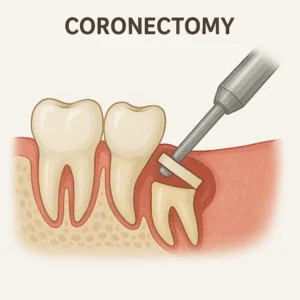Coronectomy
What is a coronectomy?
A coronectomy is when only the crown of a wisdom tooth is taken out, and the roots are left in place. This helps reduce the risk of nerve damage.
Some lower wisdom teeth are very close to a nerve that controls feeling in your lower lip, chin, gums, or tongue.
X-rays or 3D scans (cone beam CT) may show that removing the whole tooth could damage this nerve.
Leaving the roots behind with a coronectomy can reduce the risk of permanent numbness or tingling in these areas.
Note: A coronectomy isn’t suitable if the tooth has significant decay or a dead nerve—the roots must be healthy to be left behind.

What does the treatment involve?
- A small cut is made in the gum to access the tooth.
- Bone is gently removed around the tooth.
- The crown of the tooth is drilled off, and the root is smoothed.
- The gum is stitched back into place.
- The whole procedure usually takes 30 minutes.
What are the risks of coronectomy?
- Root movement or infection: About 2% of cases may need further surgery later if the roots move or cause problems.
- Need to remove roots during surgery: If the roots are loose or unhealthy, they may still need to be taken out.
- Swelling: Common and usually lasts up to 2 weeks. Using an ice pack (wrapped in a towel) can help.
- Jaw stiffness: You may not be able to open your mouth fully for a few days. Eat soft foods and maintain good oral hygiene.
- Bleeding: Some bleeding is normal. If it starts again at home, apply pressure with a damp cloth for 10 minutes.
- Infection: Can be avoided with good oral hygiene and mouthwash. Avoid smoking or vaping.
- Nerve injury: Coronectomy reduces the risk, but there’s still a small chance. You may feel numbness or tingling in the lip, chin, or tongue. This is usually temporary but rarely, can be permanent.
What type of anaesthetic will be used?
You can have the procedure with Dr Ismail done under:
- Local anaesthetic: Numbing injection in the gum—similar to getting a filling.
- Sedation + local anaesthetic: A relaxing injection in the arm, plus gum numbing.
Do I need time off work?
You may need a few days off to rest and avoid heavy physical activity.
You cannot drive for 24 hours after sedation.
Will I need a follow-up appointment?
Not always—but if needed, one will be arranged.

